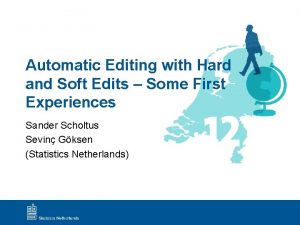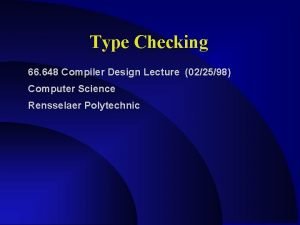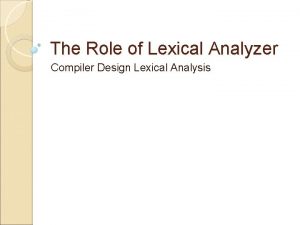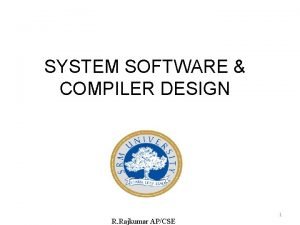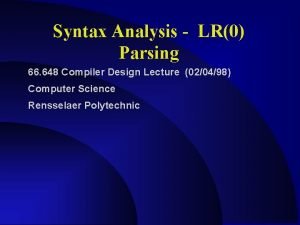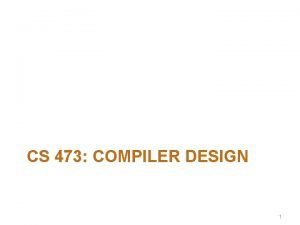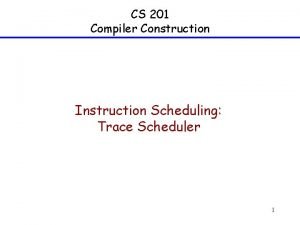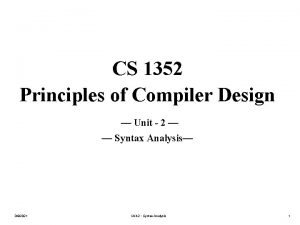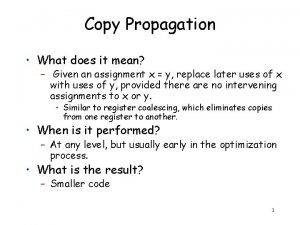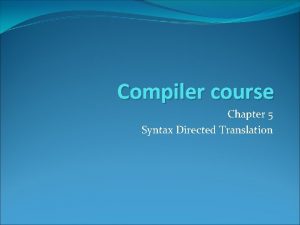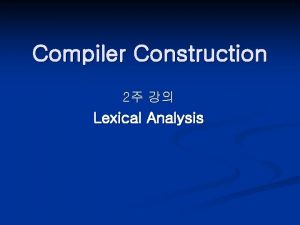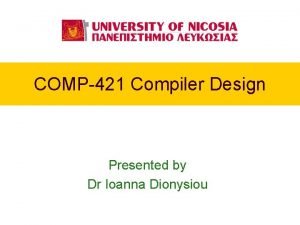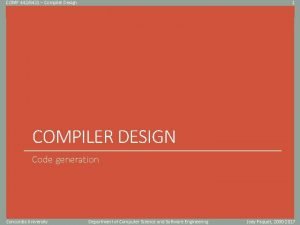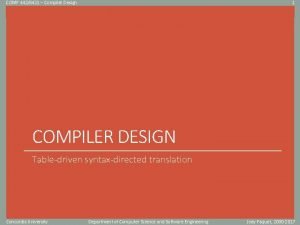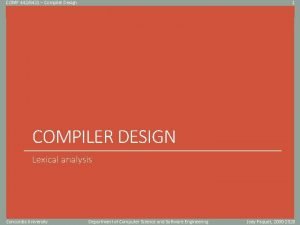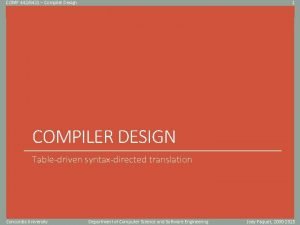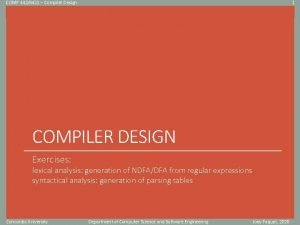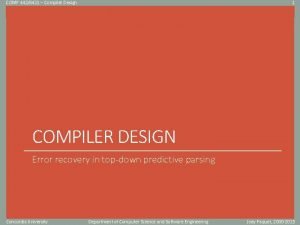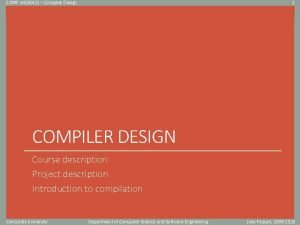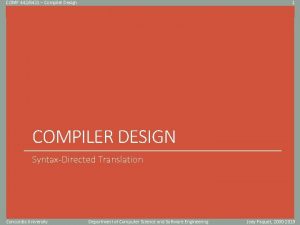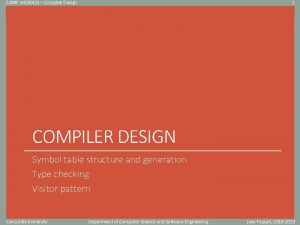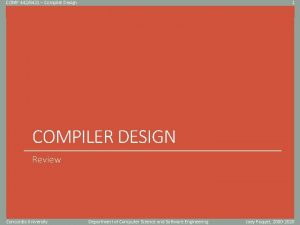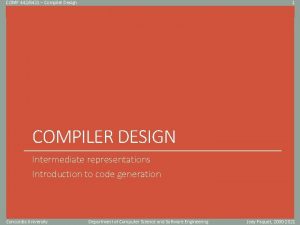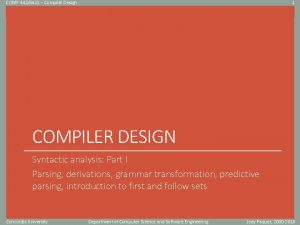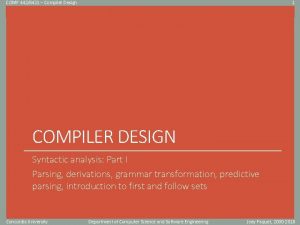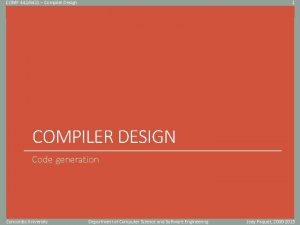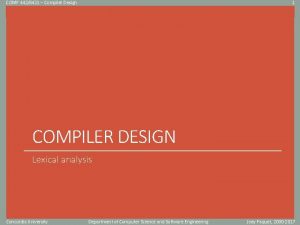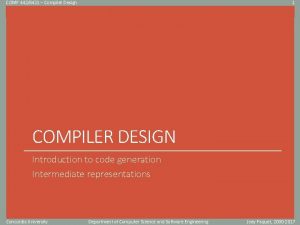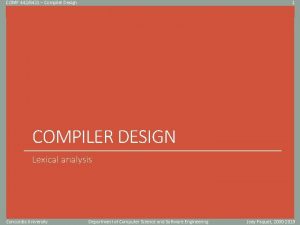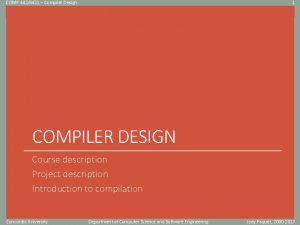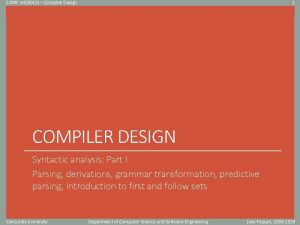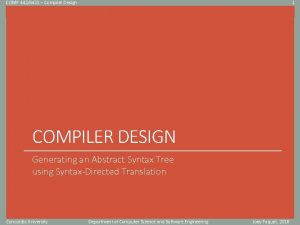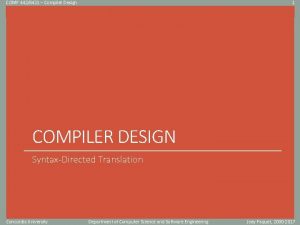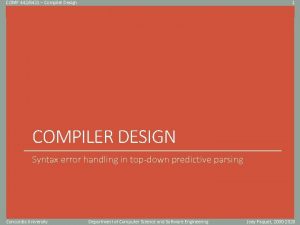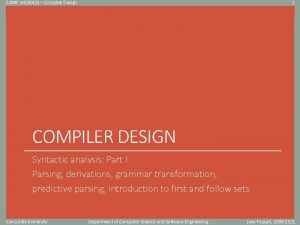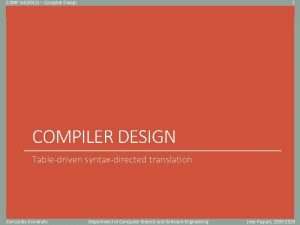COMP 4426421 Compiler Design 1 Click to edit

























- Slides: 25

COMP 442/6421 – Compiler Design 1 Click to edit Master title style COMPILER DESIGN Syntactic analysis – part II First and follow sets Recursive descent and table-driven predictive parsing Concordia University Department of Computer Science and Software Engineering Joey Paquet, 2000 -2020

COMP 442/6421 – Compiler Design 2 Click to edit Master title style Generating FIRST and FOLLOW sets Concordia University Department of Computer Science and Software Engineering Joey Paquet, 2000 -2020

COMP 442/6421 – Compiler Design 3 Generating FIRST sets • If , where begins with a terminal symbol x, then x FIRST( ). • Algorithmic definition: FIRST(A) = 1. if ( (A T) (A is ) ) then FIRST(A) {A} 2. if ( (A N) (A S 1 S 2…Sk R) | Si (N T) ) then 2. 1. FIRST(A) (FIRST(S 1) – { }) 2. 2. if i<k ( FIRST(S 1), …, FIRST(Si) ) then FIRST(A) FIRST(Si+1) 2. 3. if ( FIRST(S 1), …, FIRST(Sk) ) then FIRST(A) { } • Or, generate the lookahead tree for A Concordia University Department of Computer Science and Software Engineering Joey Paquet, 2000 -2020


COMP 442/6421 – Compiler Design 5 Example: lookahead trees 0 E TE’ FT’E’ 1 E’ +TE’ ( FIRST(E) = {0, 1, (} E E T T F TE | +TE FT | FT ( E ) | 0 | 1 FIRST(E’) = { , +} 0 T FT’ 1 ( FIRST(T) = {0, 1, (} T’ FIRST(T’) = { , } 0 F 1 ( FIRST(F) = {0, 1, (} Concordia University Department of Computer Science and Software Engineering Joey Paquet, 2000 -2020

COMP 442/6421 – Compiler Design 6 Generating the FOLLOW sets • FOLLOW(A) is the set of terminals that can come right after an A in any sentential form derivable from the grammar of the language. • Algorithmic definition: FOLLOW( 1. if ( then 2. if ( then 3. if ( then Concordia University A | A N ) = A == S ) ( FOLLOW(A) {$}) B A R ) ( FOLLOW(A) (FIRST( ) - { }) ) (B A R) ( ) ) ( FOLLOW(A) FOLLOW(B) ) Department of Computer Science and Software Engineering Joey Paquet, 2000 -2020

COMP 442/6421 – Compiler Design 7 Generating the FOLLOW sets: example E E T T F TE | +TE FT | FT ( E ) | 0 | 1 1. (1) : 2. (2) : 3. (2) : 4. (2) : 5. (3) : 6. (3) : 7. (3) : 8. (3) : 9. (3) : 10. (3) : E TE’ E’ +TE’ T FT’ T’ *FT’ F (E) E TE’ E’ +TE’ T FT’ T’ *FT’ : : : : FST(E) FST(E’) FST(T’) FST(F) : : : { { { FLW(E) FLW(E’) FLW(T’) FLW(F) (A == S) ( FLW(A) ‘$’) (B A ) ( FLW(A) (FST( ) - { }) ) (B A ) ( FLW(A) (FST( ) - { }) ) ( (B A ) ( FST( ) ) ( FLW(A) ( (B A ) ( FST( ) ) ( FLW(A) FOLLOW( 1. if ( then 2. if ( then 3. if ( then Concordia University 0, 1, ( } , + } 0, 1, ( } , * } 0, 1, ( } : : : { { { $1, )4 } {$, )}6 } {+}2, {$, )}5, 7 } {+, $, )}9 } { }3, {+, $, )}8, 10 } FLW(B) FLW(B) ) ) ) ) : : : : FLW(E) FLW(T) FLW(F) FLW(E) FLW(T) FLW(E’) FLW(F) FLW(T’) : : : { { { $, ) } +, $, ) } , +, $, ) } {$} (FST(E’) (FST(T’) (FST( )) FLW(E) FLW(E’) FLW(T) FLW(T’) – – – { }) { }) A | A N ) = A == S ) ( FOLLOW(A) {$}) B A R ) ( FOLLOW(A) (FIRST( ) - { }) ) (B A R) ( ) ) ( FOLLOW(A) FOLLOW(B) ) Department of Computer Science and Software Engineering Joey Paquet, 2000 -2020

COMP 442/6421 – Compiler Design 8 Click to edit Master title style Recursive descent predictive parsing Concordia University Department of Computer Science and Software Engineering Joey Paquet, 2000 -2020

COMP 442/6421 – Compiler Design 9 Method • Build FIRST and FOLLOW sets • For each non-terminal, we have a corresponding function • In each function, for each possible right-hand-side of the corresponding • • productions, we have a possible path to follow. The choice is made according to the FIRST set of the right hand sides. If one of the alternatives is of the form A , the path is followed according to the FOLLOW set of the left-hand-side of the production. If no valid path is found, the function returns false. If any of the paths is followed without error, the function returns true. Concordia University Department of Computer Science and Software Engineering Joey Paquet, 2000 -2020

COMP 442/6421 – Compiler Design 10 Constructing the parser • Main parser function is: parse(){ lookahead = next. Token() if (start. Symbol() match(“$”) ) return(true) else return(false)} • function to match tokens with the lookahead symbol (next token in input): match(token){ if (lookahead == token) lookahead = next. Token(); return(true) else lookahead = next. Token(); return(false)} Concordia University Department of Computer Science and Software Engineering Joey Paquet, 2000 -2020

COMP 442/6421 – Compiler Design 11 Constructing the parser • For each non-terminal in the grammar, we construct a parsing function. All parsing functions have the same form: LHS(){ if (lookahead FIRST(RHS 1) ) if (non-terminals() match(terminals) ) write(“LHS RHS 1”) ; return(true) else return(false) else if (lookahead FIRST(RHS 2) ) if (non-terminals() match(terminals) ) write(“LHS RHS 2”) ; return(true) else return(false) else if … else if (lookahead FOLLOW(LHS) ) write(“LHS ”) ; return(true) else return(false)} Concordia University // LHS RHS 1 | RHS 2 | … | // LHS RHS 1 // LHS RHS 2 // other right hand sides // only if LHS exists Department of Computer Science and Software Engineering Joey Paquet, 2000 -2020

COMP 442/6421 – Compiler Design 12 Example E E T T F TE | +TE FT | FT ( E ) | 0 | 1 E(){ // E TE’ if (lookahead FIRST(TE’) ) if (T() E’() ) write(“E TE’ ”) ; return(true) else return(false)} Concordia University Department of Computer Science and Software Engineering Joey Paquet, 2000 -2020

COMP 442/6421 – Compiler Design 13 Example E E T T F TE | +TE FT | FT ( E ) | 0 | 1 E’(){ // E’ +TE’ | if (lookahead FIRST(+TE’) ) if ( match(‘+’) T() E’() ) write(“E’ +TE’ ”) ; return(true) else return(false) else if (lookahead FOLLOW(E’) ) write(“E’ ”) ; return(true) else return(false)} Concordia University Department of Computer Science and Software Engineering Joey Paquet, 2000 -2020

COMP 442/6421 – Compiler Design 14 Example E E T T F TE | +TE FT | FT ( E ) | 0 | 1 T(){ // T FT’ if (lookahead FIRST(FT’) ) if (F() T’() ) write(“T FT’ ”) ; return(true) else return(false)} Concordia University Department of Computer Science and Software Engineering Joey Paquet, 2000 -2020

COMP 442/6421 – Compiler Design 15 Example E E T T F TE | +TE FT | FT ( E ) | 0 | 1 T’(){ // T’ FT’ | if (lookahead FIRST( FT’) ) if ( match(‘ ’) F() T’() ) write(“T’ FT’ ”) ; return(true) else return(false) else if (lookahead FOLLOW(T’) ) write(“T’ ”) ; return(true) else return(false)} Concordia University Department of Computer Science and Software Engineering Joey Paquet, 2000 -2020

COMP 442/6421 – Compiler Design 16 Example E E T T F TE | +TE FT | FT ( E ) | 0 | 1 F(){ // F 0 | 1 | (E) if (lookahead FIRST(0) ) if ( match(‘ 0’) ) write(“F 0”) ; return(true) else return(false) else if (lookahead FIRST(1) ) if ( match(‘ 1’) ) write(“F 1”) ; return(true) else return(false) else if (lookahead FIRST((E)) ) if ( match(‘(’) E() match(‘)’) ) write(“F (E)”) ; return(true) else return(false)} Concordia University Department of Computer Science and Software Engineering Joey Paquet, 2000 -2020

COMP 442/6421 – Compiler Design 17 Click to edit Master title style Table-driven predictive parsing Concordia University Department of Computer Science and Software Engineering Joey Paquet, 2000 -2020

COMP 442/6421 – Compiler Design 18 Method • Build FIRST and FOLLOW sets • Build the parser table • Implement the parser algorithm Concordia University Department of Computer Science and Software Engineering Joey Paquet, 2000 -2020

COMP 442/6421 – Compiler Design 19 Building the parsing table • Algorithm: 1. p : ( (p R) (p : A ) ) do steps 2 and 3 2. t : ( (t T) (t FIRST( )) ) add A to TT[A, t] 3. if ( FIRST( ) ) t : ((t T) (t FOLLOW(A)) ) add A to TT[A, t] 4. e : ( (e TT) (e == ) ) add “error” to e • Note: TT is the parsing table, with one row for each non-terminal, and one column for each terminal. Concordia University Department of Computer Science and Software Engineering Joey Paquet, 2000 -2020

COMP 442/6421 – Compiler Design 20 Building the parsing table E E T T F FST(E) FST(E’) FST(T’) FST(F) r 1: r 2: r 3: r 4: r 5: r 6: r 7: r 8: r 9: : : : { { { 0, 1, ( } , + } 0, 1, ( } , * } 0, 1, ( } E E’ E’ T T’ T’ F F F Concordia University TE | +TE FT | FT ( E ) | 0 | 1 TE’ +TE’ FT’ *FT’ 0 1 (E) FLW(E’) FLW(T’) FLW(F) : : : : : { { { $, ) } +, $, ) } , +, $, ) } FIRST(TE’) = FIRST(+TE’)= FOLLOW(E’) = FIRST(FT’) = FIRST(*FT’)= FOLLOW(T’) = FIRST(0) = FIRST(1) = FIRST((E)) = 1. p : ( (p R) (p : A ) ) do steps 2 and 3 2. t : ( (t T) (t FIRST( )) ) add A to TT[A, t] 3. if ( FIRST( ) ) t : ( (t T) (t FOLLOW(A)) ) add A to TT[A, t] 4. e : ( (e TT) (e == ) ) add “error” to e {0, 1, (} : {+} : {$, )} : {0, 1, (} : {*} : {+, $, )} : {0} : {1} : {(} : TT[E, 0][E, 1][E, (] TT[E’, +] TT[E’, $][E’, )] TT[T, 0][T, 1][T, (] TT[T’, *] TT[T’, +][T’, $][T’, )] TT[F, 0] TT[F, 1] TT[F, (] Department of Computer Science and Software Engineering Joey Paquet, 2000 -2020

COMP 442/6421 – Compiler Design 21 Building the parsing table r 1: r 2: r 3: r 4: E E’ E’ T TE’ +TE’ FT’ TT 0 1 ( E r 1 r 1 E’ T r 4 Concordia University r 7 r 8 T’ T’ F F F *FT’ 0 1 (E) ) + * r 3 r 2 r 6 $ r 3 r 4 T’ F r 5: r 6: r 7: r 8: r 9: r 5 r 6 r 9 Department of Computer Science and Software Engineering Joey Paquet, 2000 -2020

COMP 442/6421 – Compiler Design 22 Parsing algorithm parse(){ push($) push(S) a = next. Token() while ( top() $ ) do x = top() if ( x T ) if ( x == a ) pop() ; a = next. Token() else skip. Errors() ; error = true else if ( TT[x, a] ‘error’ ) pop() ; inverse. RHSMultiple. Push(TT[x, a]) else skip. Errors() ; error = true if ( ( a $ ) ( error == true ) ) return(false) else return(true)} *: skip. Errors() will be explained in lecture 5 Concordia University Department of Computer Science and Software Engineering Joey Paquet, 2000 -2020

COMP 442/6421 – Compiler Design 23 Table parsing example Stack Input Production Derivation 1 $E (0+1)*0$ E 2 $E (0+1)*0$ r 1: E TE’ 3 $E’T (0+1)*0$ r 4: T FT’E’ 4 $E’T’F (0+1)*0$ r 9: F (E)T’E’ 5 $E’T’)E( (0+1)*0$ 6 $E’T’)E 0+1)*0$ r 1: E TE’ (TE’)T’E’ 7 $E’T’)E’T 0+1)*0$ r 4: T FT’ (FT’E’)T’E’ 8 $E’T’)E’T’F 0+1)*0$ r 7: F 0 (0 T’E’)T’E’ 9 $E’T’)E’T’ 0 0+1)*0$ 10 $E’T’)E’T’ +1)*0$ r 6: T’ (0 E’)T’E’ 11 $E’T’)E’ +1)*0$ r 2: E’ +TE’ (0+TE’)T’E’ 12 $E’T’)E’T+ +1)*0$ Concordia University Department of Computer Science and Software Engineering Joey Paquet, 2000 -2020

COMP 442/6421 – Compiler Design 24 Table parsing example Stack Input Production Derivation 13 $E’T’)E’T 1)*0$ r 4: T FT’ (0+FT’E’)T’E’ 14 $E’T’)E’T’F 1)*0$ r 8: F 1 (0+1 T’E’)T’E’ 15 $E’T’)E’T’ 1 1)*0$ 16 $E’T’)E’T’ )*0$ r 6: T’ (0+1 E’)T’E’ 17 $E’T’)E’ )*0$ r 3: E’ (0+1)T’E’ 18 $E’T’) )*0$ 19 $E’T’ *0$ r 5: T’ *FT’ 20 $E’T’F* *0$ 21 $E’T’F 0$ r 7: F 0 22 $E’T’ 0 0$ 23 $E’T’ $ r 6: T’ (0+1)*0 E’ 24 $E’ $ r 3: E’ (0+1)*0 25 $ $ success Concordia University Department of Computer Science and Software Engineering (0+1)*FT’E’ (0+1)*0 T’E’ Joey Paquet, 2000 -2020

COMP 442/6421 – Compiler Design 25 References • C. N. Fischer, R. K. Cytron, R. J. Le. Blanc Jr. , Crafting a Compiler, Adison-Wesley, 2010 – Chapter 4 and 5. • A. V. Aho, R. Sethi and J. D. Ullman. Compilers, Principles, Techniques, and Tools, Addison-Wesley, 1986 – Chapter 4. • T. W. Parsons. Introduction to Compiler Construction, W. H. Freeman and Company, 1992 – Chapter 3 and 4. • K. C. Louden. Compiler Construction: Principles and Practice, International Thomson Publishing Inc. , 1997 – Chapter 3 and 4. Concordia University Department of Computer Science and Software Engineering Joey Paquet, 2000 -2020
 Soft edit meaning
Soft edit meaning Cross compiler in compiler design
Cross compiler in compiler design Click to edit master title style
Click to edit master title style Informaatika mitteinformaatikutele
Informaatika mitteinformaatikutele Title style
Title style Click to edit master title style
Click to edit master title style Safety click
Safety click Click clever click safe campaign
Click clever click safe campaign Clever click
Clever click Click clever click safe
Click clever click safe Yacc tutorial
Yacc tutorial Sub division of run time memory
Sub division of run time memory 022598
022598 Lexemes in compiler design
Lexemes in compiler design The designer express the ideas in terms related to the
The designer express the ideas in terms related to the Syntax analysis in compiler design
Syntax analysis in compiler design Explain compiler construction tools
Explain compiler construction tools What is frontend and backend of compiler
What is frontend and backend of compiler Single static assignment
Single static assignment Instruction scheduling in compiler design
Instruction scheduling in compiler design Terminal and non terminal in compiler design
Terminal and non terminal in compiler design Copy propagation
Copy propagation Evaluation order of sdd in compiler design
Evaluation order of sdd in compiler design Type checker in compiler design
Type checker in compiler design Attributes of tokens in compiler design
Attributes of tokens in compiler design Source language issues in compiler design
Source language issues in compiler design
